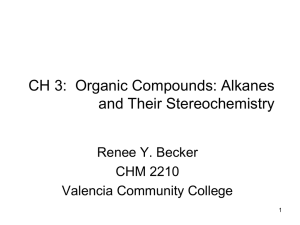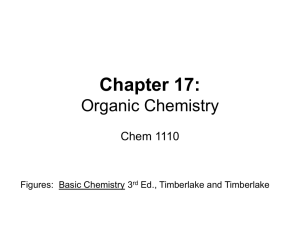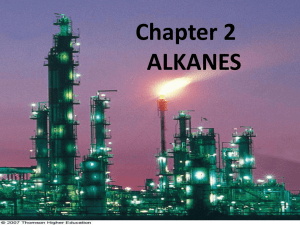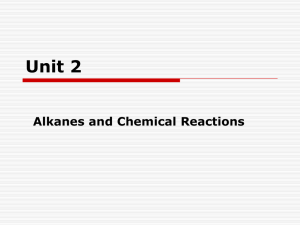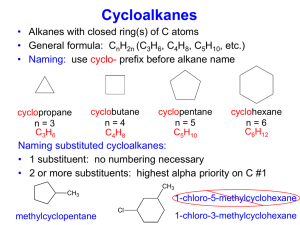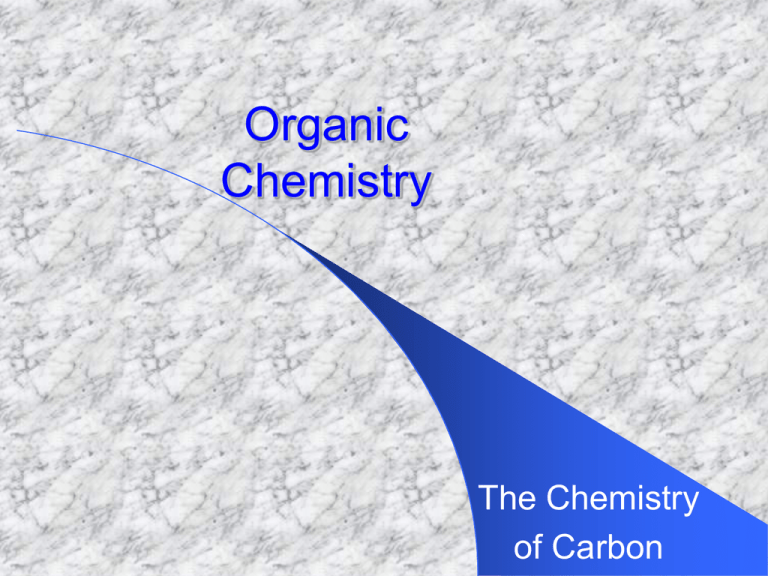
Organic
Chemistry
The Chemistry
of Carbon
Table of Contents
‘Organic Chemistry’
Distilling Crude Oil
Methane
Ethane
Propane
Butane
Pentane
Alkanes
Alcohols
Aldehydes and Ketones
Ethers
Functional Groups
Alkenes & Alkynes
Cycloalkanes
Benzene
Aromatic Hydrocarbons
Carboxylic Acids
Classes of Organic
Compounds
Chirality
Polymers
Organic Chemistry
Organic Chemistry: The chemistry of carbon
and carbon-based compounds
Organic Chemistry in everyday life:
Smells & tastes: fruits, chocolate, fish, mint
Medications: aspirin, Tylenol, decongestants, sedatives
Addictive substances: caffeine, nicotine, alcohol, narcotics
Hormones/Neurotransmitters: adrenaline, epinephrine
Food: carbohydrates, protein, fat
Genetics: DNA, RNA
Consumer products: plastics, nylon, rayon, polyester
Friedrich Wöhler
Made the first organic compound from
non-living substances. Shot down the
Vital Force idea of organic substances.
Distilling Crude Oil
Fractional
Distillation
of Crude Oil
Kelter, Carr, Scott, Chemistry A World of Choices 1999, page 429
Energy Sources
in United States
100
91
Percent
80
71
70
60
58
50
40
40
21
20
26
20
9
5
10
3
16
10
0
1850
Wood
1900
Coal
Zumdahl, Zumdahl, DeCoste, World of Chemistry 2002, page 648
1940
1980
Petroleum / natural gas
1990
Hydro and nuclear
Distilling Crude Oil
Separate fractions
based on differences
in boiling point.
American Petroleum Usage
AMERICAN PETROLEUM USAGE
A Lesson in Economics
1 Barrel of Petroleum
93% Energy Marketplace
7% Materials Marketplace
(42 gallons)
42 Gallons of Crude Petroleum
36 Gallons Fuel
At $3.00 per gallon
36 Gallons Fuel
19 Gallons Gasoline
(11 Gallons in 1920)
$108.00
OR
7% (3 Gallons Crude)
At $20.00 per shirt
100 Nylon Shirts
$2000.00
Entrepreneurs:
[Put an alligator on the shirt and make even more $$$$$]
London Dispersion Forces
The temporary separations
of charge that lead to the
London force attractions are
what attract one nonpolar
molecule to its neighbors.
Boiling points of simple
hydrocarbons in degrees Kelvin
400
C8H18
350
Temperature (Kelvin)
London forces increase with
the size of the molecules.
Fritz London
1900-1954
300
C5H12
C4H10
250
C3H8
200
C2H6
150
100
CH4
50
50
100
Molecular Weight
150
London Forces in Hydrocarbons
400
Boiling points of simple
hydrocarbons in degrees Kelvin
C8H18
350
C5H12
300
C4H10
250
C3H8
200
150
100
Simple hydrocarbons have
only London dispersion
forces as intermolecular
forces
C2H6
CH4
50
50
100
Molecular Weight
150
H
H
CH4
H
C
H
H
molecular
formula
structural
formula
H
C
109.5o
H
H
molecular
shape
H
C
H
H
H
tetrahedral
shape of
methane
tetrahedron
ball-and-stick
model
Methane is Tetrahedral
H
C
H
H
H
Methane is Tetrahedral
Zumdahl, Zumdahl, DeCoste, World of Chemistry 2002, page 634
Methane
molecular
formula
structural
formula
molecular
shape
H
CH4
H
C
H
H
H
H
ball-and-stick
model
C
H
109.5o
H
Methane
H
C
H
H
H
tetrahedron
tetrahedral
shape of
methane
ball-and-stick
model of methane
Timberlake, Chemistry 7th Edition, page 365
Lewis structure of Ethane
H
H
H
C
C
H
H
H
Space filling model of Ethane
Zumdahl, Zumdahl, DeCoste, World of Chemistry 2002, page 635
Ball and Stick model of Ethane
Structure of Propane
Zumdahl, Zumdahl, DeCoste, World of Chemistry 2002, page 635
Structure of Butane
Zumdahl, Zumdahl, DeCoste, World of Chemistry 2002, page 635
Ball and Stick Models
Ethane
Timberlake, Chemistry 7th Edition, page 366
C2H6
Propane
C3H8
First Ten Hydrocarbons
Number of
Carbon Atoms
Molecular
Formula
Methane
1
CH4
CH4
Ethane
2
C2H6
CH3CH3
Propane
3
C3H8
CH3CH2CH3
Butane
4
C4H10
CH3CH2CH2CH3
Pentane
5
C5H12
CH3CH2CH2CH2CH3
Hexane
6
C6H14
CH3CH2CH2CH2CH2CH3
Heptane
7
C7H16
CH3CH2CH2CH2CH2CH2CH3
Octane
8
C8H18
CH3CH2CH2CH2CH2CH2CH2CH3
Nonane
9
C9H20
CH3CH2CH2CH2CH2CH2CH2CH2CH3
Decane
10
C10H22
CH3CH2CH2CH2CH2CH2CH2CH2CH2CH3
Name
Condensed Structural
Formula
Hydrocarbons
(alkanes)
First Ten Hydrocarbons
Number of
Carbon Atoms
Molecular
Formula
Melting
Point, oC
Boiling
Point, oC
# of
Isomers
Methane
1
CH4
-182.5
-161.5
0
Ethane
2
C2H6
-183.2
-88.6
0
n-Propane
3
C3H8
-187.7
-42.1
0
n-Butane
4
C4H10
-138.3
-0.5
2
n-Pentane
5
C5H12
-129.7
36.1
3
n-Hexane
6
C6H14
-95.3
68.7
5
n-Heptane
7
C7H16
-90.6
98.4
9
n-Octane
8
C8H18
-56.8
125.7
18
n-Nonane
9
C9H20
-53.6
150.8
35
n-Decane
10
C10H22
-29.7
174.0
75
Name
Increasing mass and boiling point
Methane
16 g/mol
-161.5oC
Ethane
30 g/mol
-88.6oC
Propane
44 g/mol
-42.1oC
n-Butane
58 g/mol
-0.5oC
Hydrocarbons
Number of
Carbon Atoms
Alkanes
CnH2n + 2
Alkenes
CnH2n
Alkynes
CnH2n-2
1
CH4
Methane
____
_______
____
_______
2
C2H6
Ethane
C2H4
Ethene
C2H2
Ethyne
3
C3H8
Propane
C3H6
Propene
C3H4
Propyne
4
C4H10
Butane
C4H8
Butene
C4H6
Butyne
5
C5H12
Pentane
C5H10
Pentene
C5H8
Pentyne
6
C6H14
Hexane
C6H12
Hexene
C6H10
Hexyne
7
C7H16
Heptane
C7H14
Heptene
C7H12
Heptyne
8
C8H18
Octane
C8H16
Octene
C8H14
Octyne
9
C9H20
Nonane
C9H18
Nonene
C9H16
Nonyne
10
C10H22
Decane
C10H20
Decene
C10H18
Decyne
Isomers
The fat dog shook himself, and then rolled over on the wet rug.
The dog shook the fat rug, then rolled over and wet on himself.
(These two statements use the same words...
but have very different meanings.)
H
H C H
H H H H
H
H
H H H H
Methane
CH4
Butane
C4H10
H
?
R
C H
H
Methyl
-CH3
C C C C H
H H H H
R
C C C C H
H H H H
Butyl
-C4H9
Naming Alkanes
1. Find the longest continuous chain of carbon atoms in the molecule
2. Start numbering the chain at the carbon nearer the first branching point
(the substituents should have the lowest numbers possible)
3. Name and number the substituents
If there are two substituents attached to the same carbon,
assign both of them the same number
4. Write out the name of the molecule
•List the substitutents names in alphabetical order
if there are two identical substituents on the molecule, use the prefix di;
if there are three identical substituents, use the prefix tri-;
if there are four identical substituents, use the prefix tetra(alphabetize the substituents by the main name of the substituent,
not by any prefixes the substituents may have)
•Separate the substituents names with hyphens
•Tag the name of the parent chain onto the end of the substituent names
A Few Extra Rules to Follow
Use commas to separate numbers
Use hyphens to separate numbers from the substituent names
Never name alkanes after drinking
Don’t allow children to name alkanes unattended
Butane
Butane: C4H10
H H H
H
H-C-C-C-C-H
H H H
H
Butane Gas
– lighters
Kelter, Carr, Scott, Chemistry A World of Choices 1999, page 107
Structural Isomers of C4H10
butane
H H H H
H
C C C C H
H H H H
Isomers of
Butane
C4H10
H HH
H C H
H
methyl propane or isobutane
Timberlake, Chemistry
7th
Edition, page 383
C C C
H H H
H
IUPAC name
but-1-ene
cis-but-2-ene
trans-but-2-ene
2-methylpropene
C4H8
Isomers of Pentane
C5H12
These are called structural isomers.
Timberlake, Chemistry 7th Edition, page 385
H H H H
H
H
C C C C H
Butane
C4H10
C
C C C H
H
3
3
4
4
H H
Butene
Butane
C4H8
H
2-butene
2
n-butene
H H H
2
1
1-butene
H
1
C C C C H
H
H H H H
H
H H H
but(1)ene
H H CH3
H
C C C
1
6
52
43
CH3
CH3
H H C H
3
4
C C C C C C
H C H
25
CH3
H C H
16
H
3, 3 dimethyl hexane
or
Lowest sum of numbers
is correct
4, 4 dimethyl hexane
H
H
H
H
C
CH3H
H
H
CH
CHCH
CHCH
C 3C
C 2C
C 3H
H
H
H
H
CH
3
H C H
C7H16
2, 4-dimethyl pentane
H
H
molecular formula
H H H
condensed
structural
formula
H H H H
H C C C C C C C H
H H H H H H H
Heptane
shorthand
H H H
H H H H
H C H
H C C C C C C C H
H H H H H H H
H
H
H H
C C
Cl
H
H C C C
Br
H
Cl
H
H
H
C C
H H
C
H
H
C C
H
H H H
H
H C C C C H
H H
H
H C H
H
butane
2 - methylbutane
H
H
H
C C
H H
C
H
C C
H
1, 4 - pentadiene
H
H
H C C C H
Cl
3 - chloro 1 - propyne
H H
Cl
H C C C
Br
Cl
3 - bromo, 1,1 -dichloro 1 - propene
Recall: double bond is lowest number
must put substituents in alphabetical order
Naming Branched Alkanes (IUPAC)
Octane
4-ethyl
6
8
7
2
5
4
3
4-ethyl-3,5-dimethyloctane
1
3-methyl and 5-methyl = 3,5-dimethyl
1. Root name: name of longest continuous C chain (parent chain)
Two equally long? Choose the one with more branches
2. Number C atoms in chain, starting at end with first branch
3. Identify substituents, give each a number (C it is connected to)
Two or more identical substituents: use prefixes (di-, tri-, tetra-, etc.)
4. List substituents alphabetically before root name
Do not alphabetize prefixes
5. Punctuation: commas separate numbers from each other
hyphens separate numbers from names
no space between last substituent & root name
Structural Isomers: Pentane (C5H12)
pentane
2-methylbutane
2,2-dimethylpropane
Structural Isomers: Hexane (C6H14)
hexane
2,3-dimethylbutane
2-methylpentane
2,2-dimethylbutane
3-methylpentane
Structural Isomers: Heptane (C7H16)
heptane
2,2-dimethylpentane
2-methylhexane
2,3-dimethylpentane
3-methylhexane
Structural Isomers: Heptane C7H16
2,4-dimethylpentane
3-ethylpentane
3,3-dimethylpentane
2,2,3-trimethylbutane
Comparing Structural Isomers
C5H12
Structure
(Same formula, different structure)
Name
Boiling point (°C)
pentane
36.0
2-methylbutane
27.9
2,2-dimethylpropane
9.5
More branching → weaker London dispersion forces
BP/MP of Linear alkanes > BP/MP of branched alkanes
Naming Alkanes Problem Set
1.
2.
2-methylbutane
2-methylbutane
4.
3.
2,3-dimethylbutane
3,3,4-trimethylhexane
Naming Alkanes Problem Set
5. 3-ethyl-2,4,5-trimethylheptane
6. 6-ethyl-2,7-dimethylnonane
Naming Alkanes Problem Set
7.
8.
2,3,4-trimethylhexane
9.
3,3,4-trimethylhexane
4-ethyl-3-methylheptane
10.
5-tert-butyl-4-isopropyl-3methyloctane
Naming Alkanes Problem Set
11.
2,2,3-trimethylheptane
12. 6-ethyl-2-methyl-5-propylnonane
Naming Alkanes Problem Set
13.
14.
3,5-dimethyl-4-propylheptane
15.
3-ethyl-2,2,3trimethylpentane
3,4,4-trimethylheptane
16.
4-ethyl-6-isobutyl-2,9dimethyldecane
Naming Alkanes Problem Set
17. 1,1,6-trimethylhexane
4
6
8
2
1
18.
3
5
2-methyloctane
7
2-tert-butyl-4-ethyl-3-isopropylpentane
1
6
2
3
4
7
5
4-isopropyl-2,2,3,5-tetramethylheptane
Naming Alkanes Problem Set
1-sec-butyl-4-isobutyl-3-methylbutane
19.
4
6
5
2
1
10
8
3
9
7
2,5,8-trimethyldecane
20.
4,5,5-trimethylhexane
4
2
1
6
3
5
7
2,2,3-trimethylhexane
H
H C H
3,4-dimethyl octane
H C H
H H H
H H
H C C C C C
H H H H
H C H
H
H
C C H
H H
Cl Cl
H3C C C C CH2 CH3
H
CH3
3, 4 - dichloro 4 - methyl 2 - hexene
Functional Groups
Hydrocarbons in which some hydrogen atoms have been
replaced can be compared to an electric drill with attachments.
Inferring: What determines the function of the drill,
the drill itself or the attachments?
Electric drill
Forstner
drill bit
hole saw bit
Twist
drill bit
Philips
screwdriver bit
drum
sander
Alcohols (R-OH)
Methanol
(methyl alcohol)
Ethanol
R = -CH3
‘methyl’
R = -CH2CH3 ‘ethyl’
Timberlake, Chemistry 7th Edition, page 437
(ethyl alcohol)
Primary, Secondary, Tertiary
Alcohols
Primary (1o)
Alcohol
Carbon attached
to OH group
H
R1
Alkyl
group
C
Secondary (2o)
Alcohol
OH
R1
H
Tertiary (3o)
Alcohol
R2
C
R2
OH
R1
C
H
R3
CH3
CH3
OH
Examples:
H
CH3
C
OH
CH3
C
OH
CH3
C
H
H
CH3
1o
2o
3o
(One alkyl group)
(Two alkyl groups)
OH
(Three alkyl groups)
Aldehydes and
Ketones
O
Aldehyde
O
Ketone
Acetaldehyde
ethanal, ethyl aldehyde
O
(CH3CH)
Timberlake, Chemistry 7th Edition, page 453
Formaldehyde
methanal
(CH2O)
R-C-H
R-C-R'
Acetone
dimethyl ketone, 2-propanone
(CH3COCH3)
Dimethyl Ether
Dimethyl ether
– C2H6O
– Flammable
– anesthesia
Timberlake, Chemistry 7th Edition, page 446
R- Functional Groups
-CH3
methyl
-CH2CH3
ethyl
-CH2CH2CH2CH3
H
CH3CHCH2CH3
-CH2CH2CH3
propyl
sec-butyl
H
– CH2 – C – CH3
isobutyl
CH3
H
CH3CCH3
butyl
isopropyl
CH3
– C – CH3
CH3
tert-butyl
Zumdahl, Zumdahl, DeCoste, World of Chemistry 2002, page 642
Zumdahl, Zumdahl, DeCoste, World of Chemistry 2002, page 660
Ball
Space
andfilling
stick model of Ethylene
Zumdahl, Zumdahl, DeCoste, World of Chemistry 2002, page 651
Alkenes and Alkynes
Alkene
– Double bonds
ethene
Alkynes
A ball-and-stick model of ethene C2H4,
the simplest alkene.
– Triple bonds
ethyne (acetylene)
A ball-and-stick model of acetylene
(IUPAC name ethyne)
Timberlake, Chemistry 7th Edition, page 409
Saturated vs. Unsaturated
Hydrocarbons
Saturated
– Single bonds
Example:
Unsaturated
– Double & triple bonds
Example:
Aliphatic Hydrocarbons
Alkane
Alkene
Alkyne
Alkadiene
General
formula
CnH2n + 2
CnH2n
CnH2n - 2
Typical
structural
formula
–C–C–C–C–
–C=C–C–C–
–C =C–C–C–
–C=C–C=C–
butane
1-butene
1-butyne
1,3-butadiene
all single bonds
one double bond
one triple bond
two double bonds
-ane
-ene
-yne
-diene
Carbon-carbon
bond type
Naming
suffix
CnH2n - 2
Hydrogenation
(an addition reaction)
tub (soft)
margarine
+ H2
vegetable oils
unsaturated
shortening
saturated
stick margarine
Cycloalkanes
Formula
CnH2n
Condensed Structural
Formula
Geometric
Formula
Name
H2
C
H2C
H2C
C H2
Cyclopropane
H2
C
C C H2
H2
Cyclobutane
H2
C
H2C
C H2
C C
H2 H2
Cyclopentane
H2
C
H2C
H2C
C H2
C
H2
C H2
Cyclohexane
Cycloalkanes
Formula
CnH2n
Condensed Structural
Formula
Geometric
Formula
Name
Cyclopropane
Cyclobutane
Cyclopentane
Cyclohexane
Timberlake, Chemistry 7th Edition, page 388
Benzene
An Aromatic Compound
– C6H6
– Resonance structures
– Kekule’s dream
Benzene
Resonance in Benzene
Kelter, Carr, Scott, Chemistry A World d of Choices 1999, page 212
Shorthand notation of
Benzene
Structure of Benzene
H
H
C
C
C H
H C
C
H
Kelter, Carr, Scott, Chemistry A World of Choices 1999, page 212
C
H
Structure of Benzene
H
H
C
C
C H
H C
C
H
Kelter, Carr, Scott, Chemistry A World of Choices 1999, page 212
C
H
Structure of Benzene
H
H
C
C
C H
H C
C
H
Kelter, Carr, Scott, Chemistry A World of Choices 1999, page 212
C
H
Benzene
3-D
– VSEPR Diagram
Kelter, Carr, Scott, Chemistry A World of Choices 1999, page 212
Cl
Names of
monosubstituted
benzene rings
Chlorobenzene
C H3
Toluene
Br
OH
Bromobenzene
Phenol
N O2
Nitrobenzene
C H = C H2
Styrene
Benzene
Mark Wirtz, Edward Ehrat, David L. Cedeno*
NO3-
Nitrobenzene
Aromatic Hydrocarbons
Kelter, Carr, Scott, Chemistry A World of Choices 1999, page 430
Cholesterol Compounds
CH3
6
C
C
1
C ortho
C
2
5
C
para
4
C
3
meta
position number
1, 2
1,3
1,4
name
ortho- (o-)
meta- (m-)
para- (p-)
CH3
H
6
C
C
1
C CH3
H C
2
5
C
H
4
C
3
H
ortho-dimethylbenzene
or
1, 2 - dimethylbenzene
CH3
H
6
C
C
1
C H
H C
2
5
C
H
4
C
3
CH3
meta-dimethylbenzene
or
1, 3 - dimethylbenzene
CH3
H
6
C
C
1
C H
H C
2
5
C
4
CH3
C
3
H
para-dimethylbenzene
or
1, 4 - dimethylbenzene
MD
H
6
C
C
1
C H
H C
2
5
C
4
MD
C
3
H
para-docs
or
paradox
MD
H
6
C
C
1
C MD
H C
2
5
C
H
4
C
3
H
ortho-docs
or
orthodox
Fe2+
Fe2+
6
C
C
1
C Fe2+
Fe2+ C
2
5
C
4
Fe2+
C
3
Fe2+
ferrous wheel
or
ferris wheel
NO2
H
C
C
C NO2
H C
C
H
C
H
o - dinitrobenzene
or
1, 2 - dinitrobenzene
NO2
CH3
C
C
C H
O 2N C
C
H
C
NO2
2,4,6 - trinitrotoluene
or
TNT
C H3
CH3
Cl
C
C
Toluene
C Cl
H C
C
Cl
C
H
2, 4, 6 -trichloromethylbenzene
or
2, 4, 6 - trichlorotoluene
O
O C CH3
H
C
C
C COOH
H C
C
H
C
H
2-acetyloxybenzoic acid
or
(acetylsalicylic acid or aspirin)
H
H
C
C
C
H
C
H
C C
Cl C
H
H
C
CClCl
Cl C
3
C
C
Cl
H
H
dichlorodiphenyltrichloroethane
or
DDT
C
C
C
H
Cl
CH CH2
H
C
C
C H
H C
C
H
C
H
n
phenyl ethene
or
poly styrene aka
(styrofoam)
Carboxylic
Acids
COOH
O
R–
- COOH
C – OH
COOH
CH3CHCH2CH2COOH
Br
4-Bromopentanoic acid
Benzoic acid
N O2
p-Nitrobenzoic acid
CH2CH2COOH
Cl
3-Chloropropanoic acid
Classes of Organic Compounds
Class of
Compound
halocarbon
Functional
Group
F, Cl, Br,
I
alcohol
General
Formula
R X
R OH
OH
ether
aldehyde
ketone
O
R O R’
O
O
C
R C
O
O
C
R C
O
carboxylic acid
C
amine
amide
C
R’
O
OH
R
C
OH
O
O
ester
H
O
NH2
O
C NH2
R C
OR’
R NH2
O
R C NH2
Example
CH3Cl
chloromethane
CH3CH2CH2OH
1-propanol
CH3OCH2CH3
methoxyethane
O
CH3CH2CH
propanal
O
CH3CCH3
propanone
O
CH3CH2COH
propanoic acid
O
CH3COCH3
methylethanoate
CH3CH2CH2NH2
propanamine
O
CH3CH2CNH2
propanamide
Organic Nomenclature Flow Chart
Functional
Groups
Functional
Groups
Timberlake, Chemistry 7th Edition, page 403
Order of Priority of Functional Groups
Order of
priority
Functional group
Formula
Order of
priority
Functional group
Formula
1
Carboxylic acid
-COOH
8
Ketone
-CO
2
Sulfonic acid
-SO3H
9
Alcohol
-OH
3
Ester
-COOR
10
Phenol
-OH
4
Acid chloride
-COCl
11
Thiol
-SH
5
Amide
-CONH2
12
Amine
-NH2
6
Nitrile
-CN
13
Ether
-OR
7
Aldehyde
-CHO
14
Sulfide
-SR
Selinger, Chemistry in the Marketplace, 1994, page 23
Esters
O
R – C – O – R’
H H O
H
C C C O CH
H 3
from propanoic acid
methyl group
H H
an
ester
a carboxylic
acid
propanoic acid
An ester is similar to a carboxylic acid,
but the acidic hydrogen has been
replaced by an alkyl group
methyl propanoate
Naming Esters
O
R – C – O – R’
Name the following ester:
O
CH3CH2CH2COCH2CH3
Step 1) the ester alkyl group (R’) = ethyl
Step 2) the acid (R) = butanoic acid
Step 3) the name = ethyl butanoate
Formation of an Ester
H H H O
H
C C C C O
OH
H +
Ester
Ester
Lab I
Lab II
H H
HO C C H
H H H
butyric acid (butanoic acid)
H H
ethyl alcohol
+
water
ethyl butyrate (tastes and smells like pineapple)
D
Ketone
H O H
H H
H C C C C C H
1
H
2
3
4
5
O
R C R'
H H H
2-pentanone
C5H10O
Ester
H H O
H
H C C C O C H
2
3
H H
3 carbons = propane
1
O
R C O R'
H
R'
methyl propanoate
1) Name the R' first (R' = methyl)
2) Find carbon chain and include the
carbonyl carbon.
3) Drop the ending and add -yl
C 4 H 8 O2
O
Ester
CH3
O
H C O C CH3
Raspberry
R C O R'
H
H O
CH3
H C C O CH2 CH2 C CH3
H
CH3
Banana
H O
H C C O CH2 (CH2)6 CH3
H
PP
Ester
Lab
Orange
Ester
H O
O
H C C O CH2 CH2 CH3
H
R C O R'
Pear
H
H
C
H O
C
H C C O CH2 C
H
Peach
C H
C
H
C
H
Carboxylic acid
H
O
R C
H C H
OH
H
H
H C
C
5
4
H H
H
C
3
H
O
C C
2
H
1
OH
3-methylpentanoic acid
C6H12O2
Ether
R O R'
H H
H H H H
H C C O C C C C H
H H
H H H H
ethyl butyl ether (common name)
or
ethoxybutane (IUPAC)
C6H14O
Alcohol
3-ethyl-3-hexanol
H
R OH
H C H
H C H
H H
H H
H C C C C C
H H
H H
H
C H
H
C8H18O
OH
Carboxylic acid
O
R C
H
H
OH
O
C C
H
OH
ethanoic acid
C 2 H 4 O2
Alcohol
H
H H
R OH
HO C C C OH
H H H
1,3-propanediol
C 3 H 8 O2
Draw structural formulas for the following:
a.
3-heptene
b.
trichloromethane
c.
2-chloro-3-phenylhexane
d.
1,3-cyclopentadiene
e.
toluene (methylbenzene)
f.
1,4-dibromobenzene
g.
2-bromo-3-methyl-2-butene
Write the condensed formulas for the following haloalkanes:
a.
ethyl chloride (common name) or chloroethane (IUPAC)
b.
bromomethane
c.
1-bromo-3-chlorocyclopentane
d.
1,1-dichlorocyclohexane
e.
2,2,3-trichlorobutane
f.
2,4-dibromo-2,4-dichloropentane
Write a correct IUPAC (or common name) for the following:
a.
CH3CH2Br
b.
Cl Cl
bromoethane (ethyl bromide)
2,3-dichlorobutane
Cl
CH3CHCHCH3
c.
chlorocyclopentane
Cl
Br
d. CH3CH2CHCH2CHCH3
e.
2-bromo-4-chlorohexane
Cl
F
1-chloro-1-fluorocyclobutane
Draw structures for the following:
1,1,1-trifluoroethane
cis-2-butene
1-heptyne
2-chloro-4,5-diethylnonane
cyclohexane
ethylcyclopropane
meta-dichlorobenzene
2,4,6-trinitrotoluene
ortho-iodotoluene
ethyl pentanoate
2-bromohexanal
methyl propanamide
propoxypropane (propylpentyl ether)
m-iodophenol
1,3-propanedioic acid
propylamine
1,4-butandiol
3-chloropentanoic acid
1,3-dibromo-2-propanone
methyl-3-chloropropyl ether
3-hydroxy-1-pentyne
F
F
H
C C H
F
H
1,1,1-trifluoroethane
C2H3F3
H
H
C C
H 3C
H
H3C
C C
CH3
cis-2-butene
H
CH3
trans-2-butene
C 4H 8
H H
H H H H
H C C C C C C C H
H H H H H H
1-heptyne
C7H12
H H H
H H H H
H C H
H C C C C C C C H
H H H H H H H
H
H
H H
C C
Cl
H
H C C C
Br
H
Cl
H
H
H
C C
H H
C
H
H
C C
H
Chirality: Chiral vs. Achiral
right shoe
left mitt
Chiral
right-handed
scissors
glass
plate
Achiral
tennis
racket
Chirality
H
mirror
H
H
H
Cl
Cl
Br
Cl
I
Timberlake, Chemistry 7th Edition, page 484
Br
I
Br
Cl
Br
I
I
“cis” and “trans” isomers
Geometric Isomers
H
H3C
C=C
H
C=C
CH3
H3C
H
cis-2-butene
(same side)
Timberlake, Chemistry 7th Edition, page 414
trans-2-butene
(opposite side)
CH3
H
Geometric Isomers
Isomerism
trans
cis
Stereoisomers
(Structural Isomers)
mirror images
Other Functional Groups to Recognize
Ethers
Amines
Amides
(“EETH erz”) (“uh MEENZ”) (“uh MIDZ” or “AM idz”)
–N
“coca-ine”
“Tatoo-ine”
“caffe-ine”
=
–O–
O
–C–N
Organic Reactions
combustion of hydrocarbons OR compounds w/only
C, H, and O: products are…CO2 and H2O
Write the equation for the complete
combustion of 2-methyl-2-pentene.
C6H12 + 9 O2 6 CO2 + 6 H2O
O
Write the equation for the complete
combustion of ethylbutanoate.
O
C6H12O2 + 8 O2 6 CO2 + 6 H2O
substitution: an H atom is removed and “something
else” is put in its place
halogen atom replaces an H.
-- In halogenation, a _______
Write an equation for the reaction
between ethane and chlorine.
H H
H H
H –C–C–H + Cl2 H–C–C–Cl + HCl
H H
H H
If more chlorine is provided,
the reaction will produce...
H H
H H
H –C–C–Cl + Cl2 Cl–C–C–Cl + HCl
H H
H H
AND SO ON.
Substitution occurs with aromatic compounds, too.
Br
+ Br2
+ CH3CH2Cl
catalyst
catalyst
+ HBr
+ HCl
Ethylbenzene is an important
intermediate in the production
of styrene which, in turn, is
used to make polystyrene.
Roughly 25 million tons of
ethylbenzene are produced and used every year.
addition: a multiple bond is broken and
two “things” are inserted
H H
H
H
Br–C–C–Br
+ Br2
C=C
H
H
H H
H H
H
H
H–C–C–Br
+ HBr
C=C
H
H
H H
H H
H
H
H2SO4
H–C–C–OH
+ H2O
C=C
H
H
H H
H
H
H Cl
H
H–C–C–C–C–H + Cl2
H –C–C=C–C– H
H
Cl H
H
H
A specific addition rxn is hydrogenation, in which
__
H is added across a multiple C-C bond.
-- requires a catalyst (usually a finely-divided
_____)
metal to rupture the multiple bond
H
H
+ H2
C=C
H
H
catalyst
H H
H–C–C–H
H H
Another addition reaction is polymerization.
H
H
H H H H
C=C
H
H
H H
–C–C–C–C–
C=C
H
HH
H
H H H H
C=C
H
H “lots” of ethylene
polyethylene
condensation
(or elimination,
or dehydration):
water is a product
_____
-- One reactant provides an __,
H
the other provides an ___.
OH
Complex protein
molecules are
made from
condensation
reactions of
amino acids.
NO2
+ HNO3
H2SO4
CH3CH2OH + CH3OH
alcohol m’c
alcohol m’c
+ H2 O
CH3CH2–O–CH3 + H2O
an ether
water
-- Amides can be formed in condensation rxns
between carboxylic acids and amines.
Write the equation for the reaction between
butanoic acid and nitrogen trihydride.
Ammonia is the simplest amine.
O
O
+ NH3
+ H2 O
OH
carboxylic acid amine
NH2
amide
water
Esterification is a condensation reaction between a
carboxylic acid and an alcohol.
Write the equation for the reaction between
butanoic acid and 1-butanol.
O
+
OH
HO
O
+ H2 O
O
butylbutanoate
(the active substance in
the characteristic
flavor/odor of pineapple)
Write the equation for the reaction between
3-phenyl-2-propenoic acid and ethanol.
O
+ HO
OH
O
+ H2O
O
ethyl-3-phenyl-2-propenoate
(i.e, ethyl cinnamate )
(the active substance in
the characteristic
flavor/odor of cinnamon)
“When in doubt,
make water.”
Mr. B
Amino Acid
NH21-
NH3
NH41+
Amine
Ammonia
Ammonium ion
Polymers
monomer
Jaffe, New World of Chemistry, 1955, page 603
homo
chain polymer
monomer
copolymer
Copyright © 2007 Pearson Benjamin Cummings. All rights reserved.
Polymerization
Polymers = Monomer + Monomer + …
Synthetic Polymers
–
–
–
–
Nylon
“plastics”
Vulcanized rubber
polyethylene
Natural Polymers
– Silk
– Proteins (amino acids)
– Starch (sugars)
Polymers
H2C = CH2
– CH2 – CH2 – CH2 – CH2 –
Ethene (ethylene)
Polyethylene
Cl
H2C = CH
Chloroethene
(vinyl chloride)
Cl
Plastic bottles, film,
insulation material
Cl
– CH2 – CH – CH2 – CH –
Polyvinyl chloride (PVC)
Plastic pipes and
tubing, garden
hoses, garbage bags
Polymers
CH3
CH3CH = CH2
Propene (propylene)
CH3
– CH2 – CH – CH2 – CH –
Ski and hiking
clothing, carpets,
artificial joints
Polypropylene
F
F
F–C=C–F
Tetrafluoroethene
F
F
F
F
–C–C–C–C–
F
F
F
Teflon
F
Nonstick coatings
Polymers
Cl
H2C = C – Cl
1,1 Dichloroethene
Cl
Cl
– CH2 – C – CH2 – C –
Cl
Plastic film
and wrap
Cl
Saran
H2C = CH
Phenylethene
– CH2 – CH – CH2 – CH –
Polystyrene
Plastic coffee
cups and cartons,
insulation
Slime
PVA + PVA + PVA
– With cross-linking agent
(borax solution)
What are some things you think of
when I say organic?
•
•
•
•
•
•
•
Medicine
Plastics
Soil
Soap
Petroleum
Grass
Clothing
PRISM fellow: Mr. Kevin J. Hodel
•
•
Organic - the study of carbon containing
compounds that their properties
Why carbon??
Strong bonds
between carbons
Low reactivity of
carbon compounds
Geometry of carbon
compounds
PRISM fellow: Mr. Kevin J. Hodel
Diamonds
PRISM fellow: Mr. Kevin J. Hodel
Graphite
PRISM fellow: Mr. Kevin J. Hodel
Polymers
•
Polymer - a large organic molecule
composed of smaller units bonded together
– These smaller units are called monomers.
•
Tires
–
Vulcanized rubber was discovered by
mistake!!
•
soft and weak until heated then forms disulfide
linkages between the rubber polymers.
PRISM fellow: Mr. Kevin J. Hodel
Natural Polymers
•
•
•
Rubber
Cotton
Paper
–
•
Cotton and paper are made of cellulose
which is the most abundant natural polymer
in the world.
Starch
–
Potatoes, corn, bread
PRISM fellow: Mr. Kevin J. Hodel
Synthetic Polymers
•
•
Half of the industrial chemists work in
some area of polymer chemistry.
In 1996, more than 270 lbs of plastic was
produced per person in the US.
PRISM fellow: Mr. Kevin J. Hodel
Types of Synthetic Polymers
•
Elastomers - can be highly stretched
and returns to their original shape.
•
Fibers - polymers that exhibit little or no
elasticity (threadlike)
•
Plastics - synthetic polymers that are
more elastic than fibers but less elastic
the elastomers.
PRISM fellow: Mr. Kevin J. Hodel
Common Polymers
• Polystyrene foam can be made into cartons to protect eggs or into
packing “peanuts” to cushion fragile objects for shipping.
– CH2 – CH – CH2 – CH –
Plastic coffee
cups and cartons,
insulation
Polystyrene
• Polyethylene: You probably see polyethylene every day! It’s the
plastic used to make many containers, among other things.
– CH2 – CH2 – CH2 – CH2 –
Polyethylene
Plastic bottles, film,
insulation material
• Water-resistant paints and varnishes derive from a family of
synthetic polymers called acrylics.
PRISM fellow: Mr. Kevin J. Hodel
Recycling
• Before: Milk jug.
After: Picnic table.
• Before: Bread bag.
After: Trash can.
• Before: Sandwich box.
After: Frisbee.
PRISM fellow: Mr. Kevin J. Hodel
Plastic Resin Codes
Copyright © 2007 Pearson Benjamin Cummings. All rights reserved.
Addition Reactions
H
H
C C
H
+ H–H
Ni
H
H
H
H
C C
H
H H
H
C C
H
H H
H Br
+ Br – Br
Ni
H
C C
Br H
H
Acid-Catalyzed Hydration
H
H
C C
H
H H
+ H – OH
H2SO4
H
H
H
H OH
water
ethene
C C
ethanol
Write out the mechanism for the formation of isopropyl alcohol
(used as rubbing alcohol), from propene.
H
H
C C
H
H H
+ H – OH
H
ethene
H2SO4
H
C C
OH H
water
ethanol
H
180o
Molecular Geometry
109.5o
Trigonal planar
Linear
Tetrahedral
107.3o
Trigonal pyramidal
104.5o
Bent
H2O CH4 AsCl3 AsF5
BeH2
BF3 CO2
Order of Priority of Functional Groups
Order of
priority
Functional group
Formula
Order of
priority
Functional group
Formula
1
Carboxylic acid
-COOH
8
Ketone
-CO
2
Sulfonic acid
-SO3H
9
Alcohol
-OH
3
Ester
-COOR
10
Phenol
-OH
4
Acid chloride
-COCl
11
Thiol
-SH
5
Amide
-CONH2
12
Amine
-NH2
6
Nitrile
-CN
13
Ether
-OR
7
Aldehyde
-CHO
14
Sulfide
-SR
Selinger, Chemistry in the Marketplace, 1994, page 23


